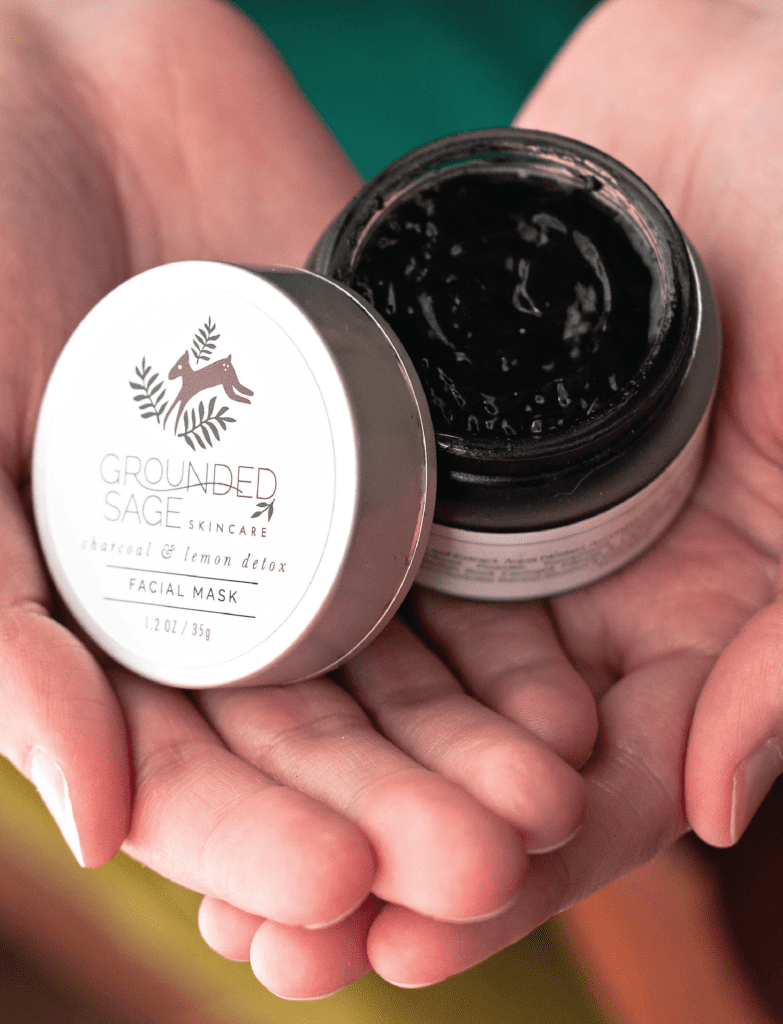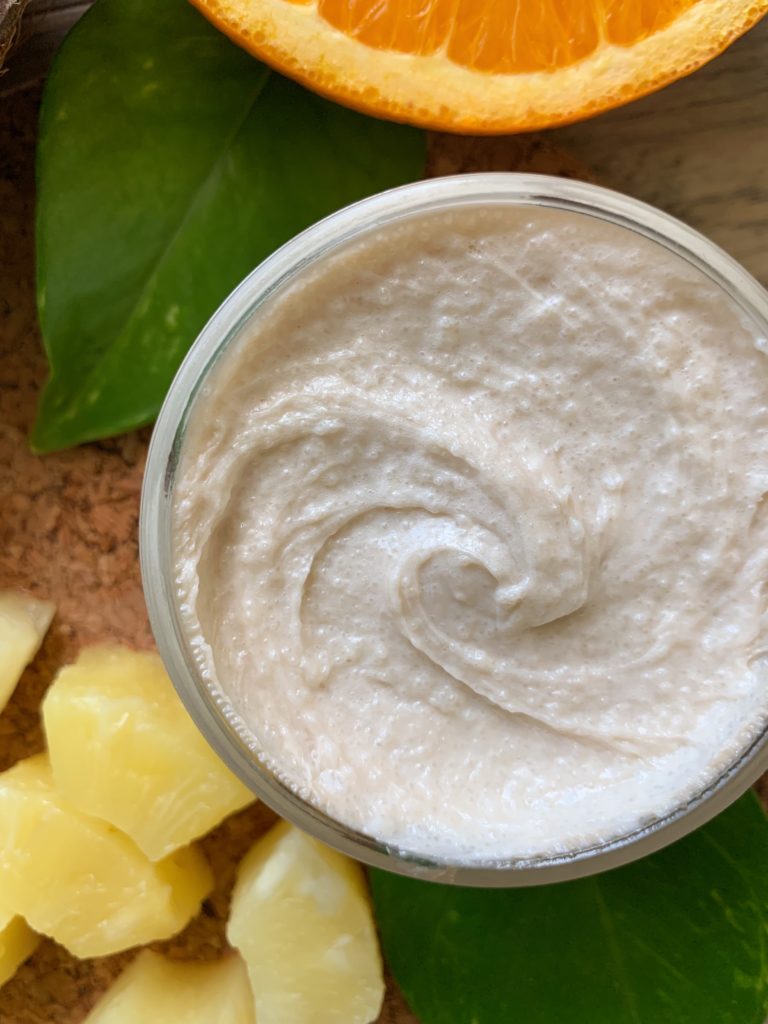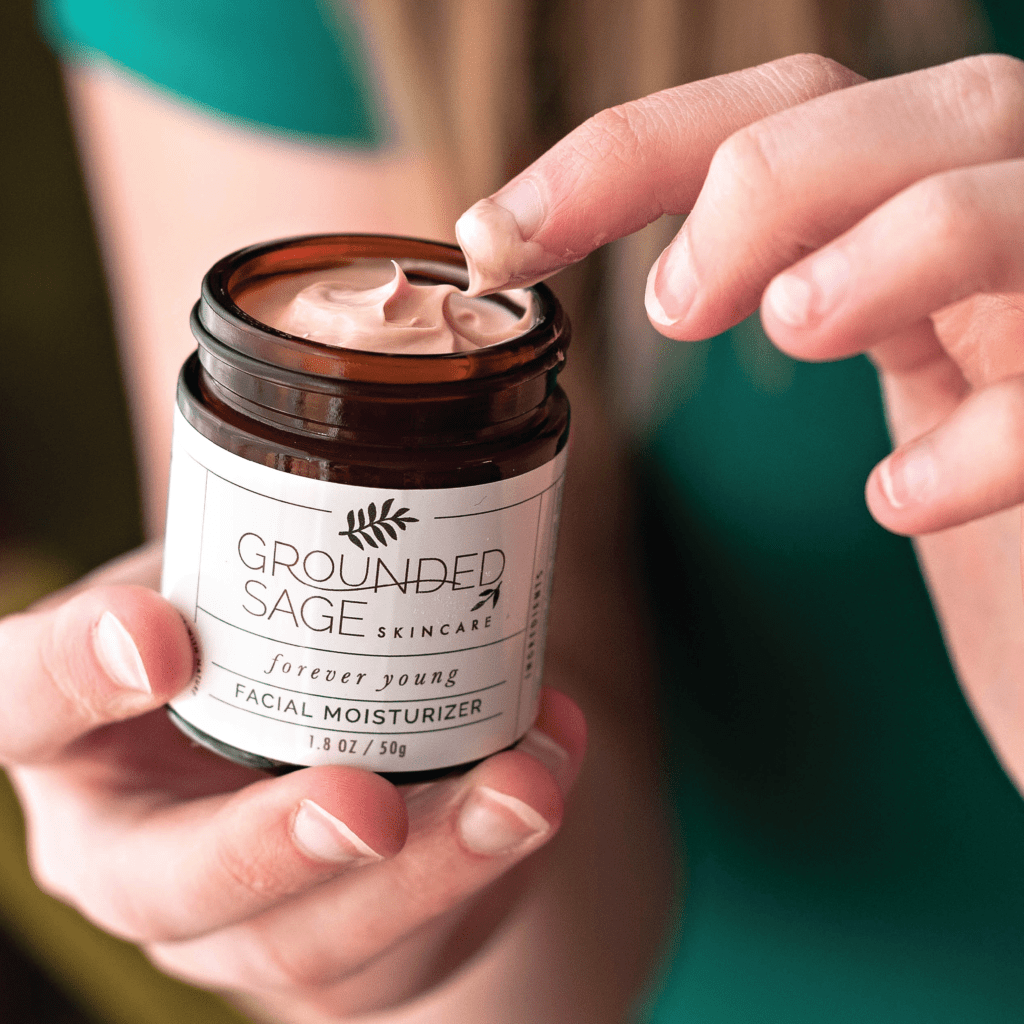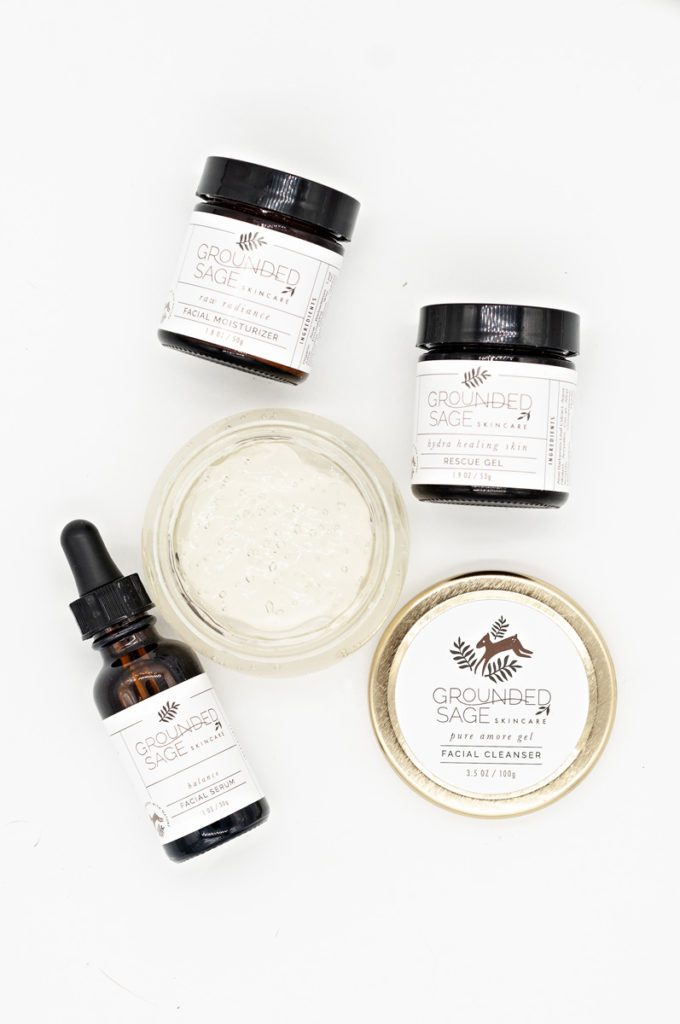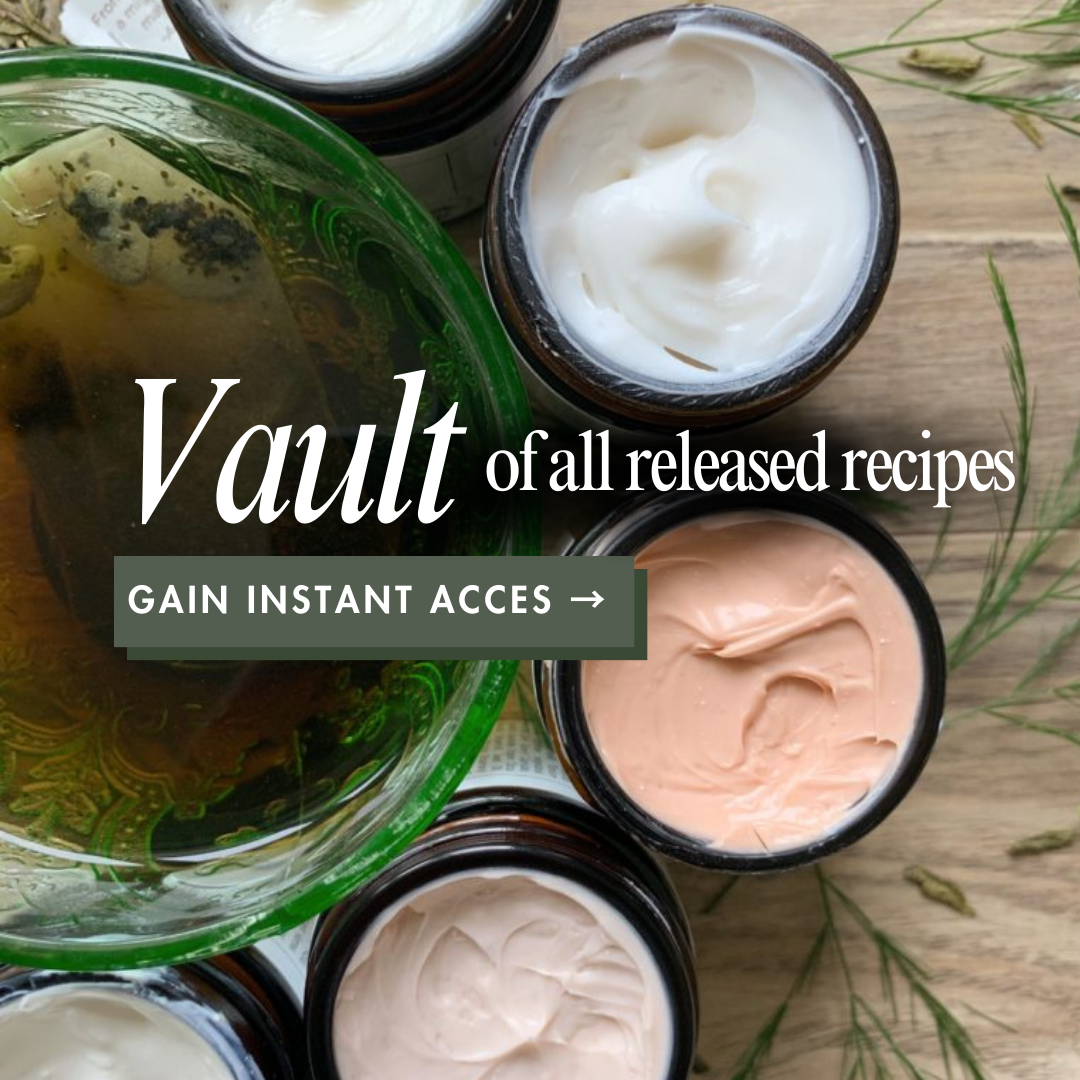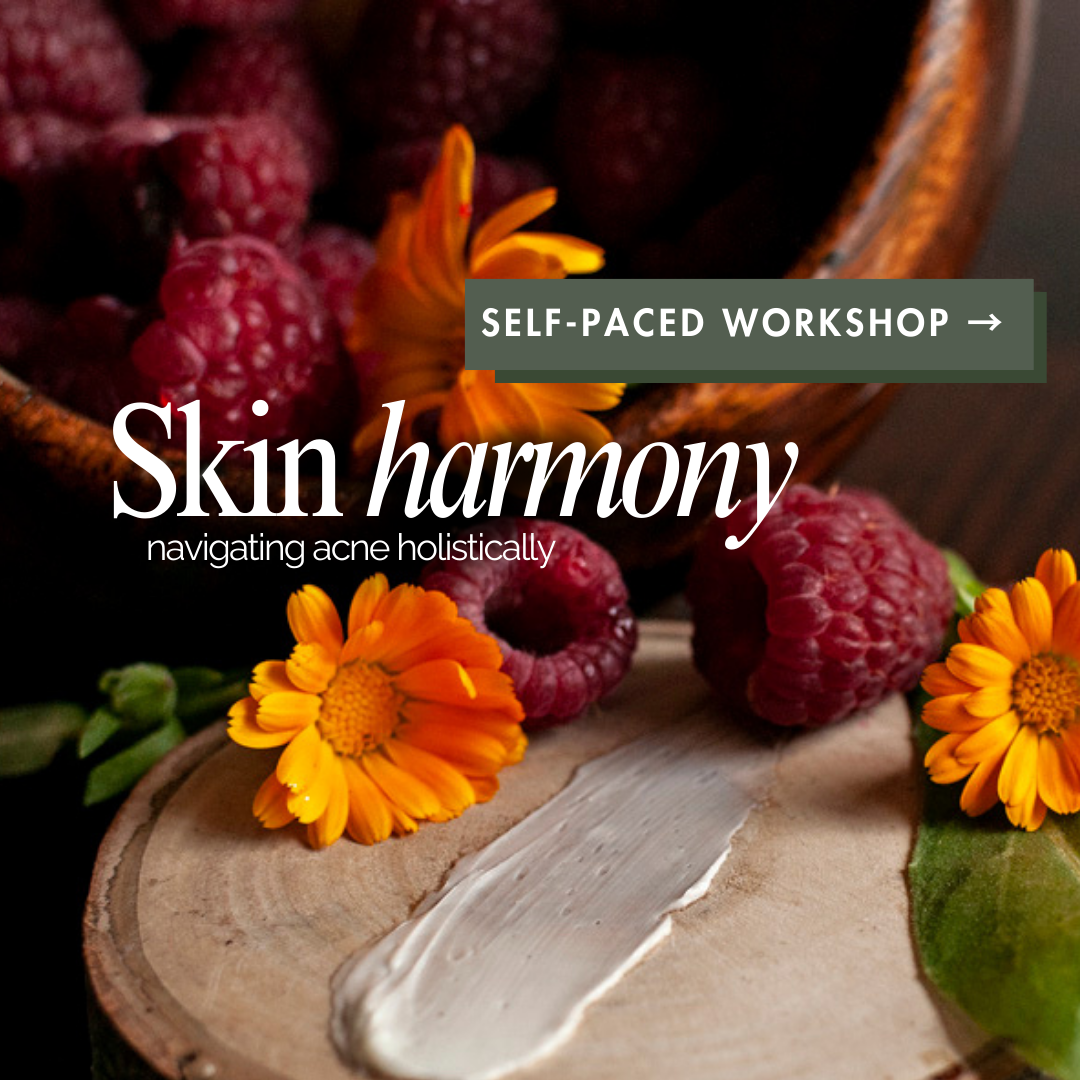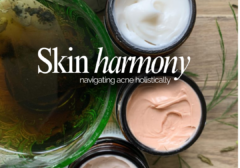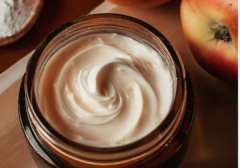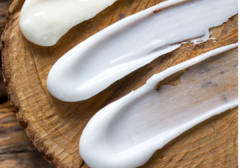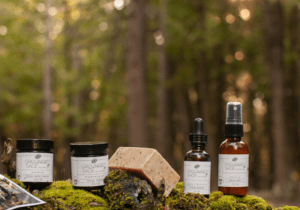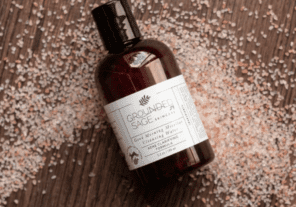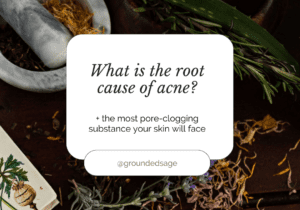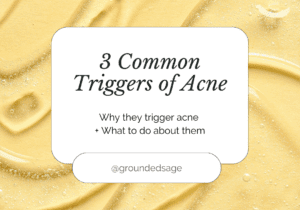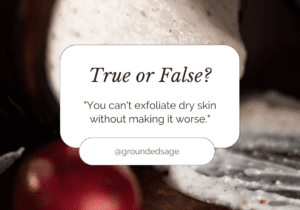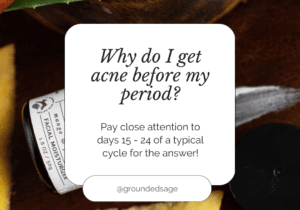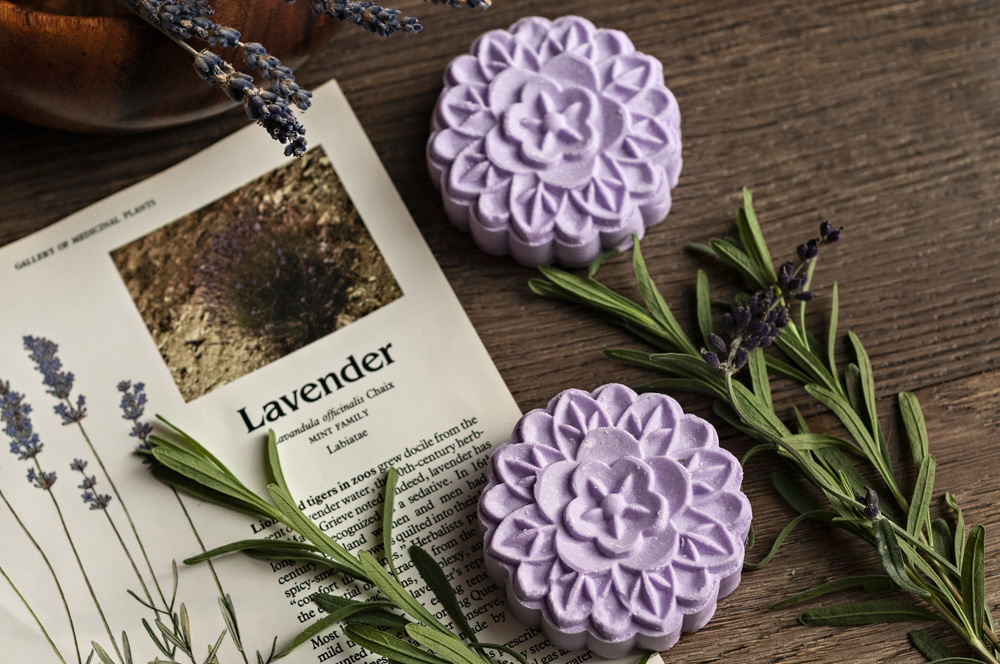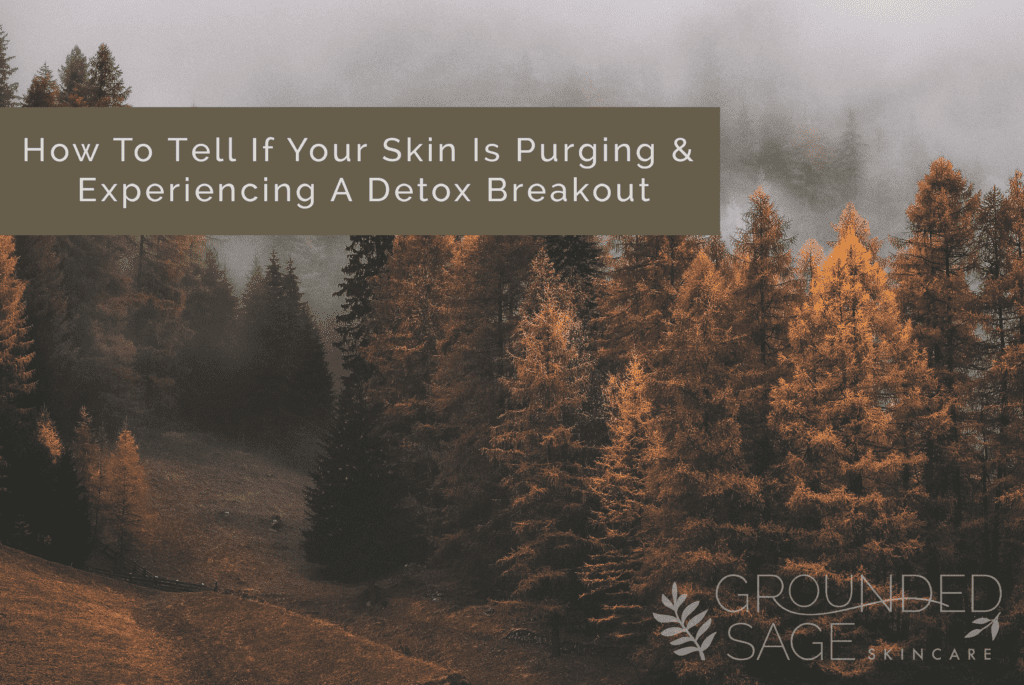
Today I wanted to answer a common acne question: is it a detox breakout or something else?
When we start detoxing our skin, using natural products, change our skincare routine, or go through any sort of hectic period or transition in life it can be hard to figure out if your skin purging (which is a good thing), or if it’s downright upset about something!
Detox breakouts and purges look similar, and sometimes exactly the same, as when our skin is breakout out due to internal (hormones, diet, inflammation) or external (skincare, heat, friction, inflammation) tractors that don’t agree with it.
So today I’d like to give you some insight on how to start figuring out if it’s a purge or not.

First, let’s talk about what our skin is doing when it’s purging or experiencing a detox breakout.
- Our skin is “purging” when it’s getting rid of the gunk in our pores like trapped dead skin cells. Remember, the inside of your pores shed skin cells too! This means exfoliating OUTSIDE your pores, with a surface scrub, for example, doesn’t mean the inside of your pores are getting cleaned out.
- Excess oil (sebum) and dead skin cells are the most common “debris” trapped in our pores.
- When this debris gets trapped, it blocks additional debris from being purged from the pore.
- When enough sebum gets trapped, bacteria come along – they are attracted to sebum as it’s their main food source (gross, I know!)
- When the bacteria show up, our immune system enters the scene to get things under control – this results in inflammation and some handy work by our bodies to start to heal the clog, irritation and big fat breakout!

So why is this a detox breakout?
When we’re actively looking to unclog our pores, free up congestion, and purge our skin of anything that’s lurking around (comedogenic, irritating, or toxic ingredients for example), we speed up the process of going from “trapped debris” to “bye-bye debris” in our pores more rapidly. Essentially, we bring about the breakout process that would have happened anyway, but faster. The faster the process happens, the faster we have skin that’s unclogged, free of debris, and on its way to being breakout free.
This is why if you’re experiencing a detox breakout or skin purge, the best thing you can do is stay the course as it will be totally worth it. The breakouts will come one way or another when our skin needs to purge, with a detox breakout you’re in control of how fast. Once your skin has finished purging, the key is to take steps to keep your pores from getting clogged again – that way you won’t have to go through another detox breakout.

So how can you if it’s a detox breakout or something else bothering your skin?
Detox breakouts are generally related to 3 things:
- ingredients that speed up the purging process
- ingredients that shouldn’t be in an acne-prone routine in the first place
- ingredients that your specific skin is sensitive / irritated by

Let’s first talk about ingredients that speed up the purging process.
These include ingredients that increase cell turn over and ingredients that encourage detox by helping to clear the way inside our pores.
Here are some of the most common in natural skincare:
- Clays. Especially Australian Green Clay (the most powerful of the clays for detoxifying). Clays are found in products like our Quick Calm Calendula & Pink Clay Mask.
- Manual exfoliating ingredients like jojoba beads (which are natural plant wax formed into the shape of small round exfoliating balls). Found in products like Pineapple Facial Scrub and Mild Jojoba Scrub. It’s important to note here that manual exfoliation using a bath mitt, washcloth, or especially something like a pulsing/rotating/automatic face brush (like a Clarisonic) would fall under this category as well.
- Enzyme/AHA exfoliating ingredients like vitamin c and extracts of pineapple, sugar cane, orange, lemon, sugar maple, and bilberry. Found in products like Congestion Protection AHA Mist (toner), Pure Amore Gel Cleanser, Green Tea & Pineapple Facial Cleanser, and Pineapple Facial Scrub.
- Aloe. No surprise it’s at the top of the list since it’s a go-to natural ingredient for both hydration and calming/healing. Found in products like Hydra Healing Skin Rescue Gel and Acne & Oil Balancing Mask.
- Calming fruit, flower and plant extracts like cucumber, calendula, marshmallow root, and watermelon. Found in products like Raw Radiance Facial Moisturizer and the Calendula Line.
- Hydrosols / floral waters like the chamomile, rose, yarrow, rosemary, and lemon balm. Found in products like Hydration Mist (toner), Acne B.O.P. Mist (toner), and Congestion Protection AHA Mist (toner).
- Hyaluronic acid is the ultimate hydrating ingredient. Found in products like Nature’s Veil CC Cream (tinted moisturizer).
- Activated Charcoal is able to absorb debris, toxins and chemicals (it actually has its own pores that are capable of holding 1000x its own weight – talk about powers of absorption!) found in products like Charcoal & Lemon Detox Mask and Charcoal Soap.
- Dead Sea Mud and Seaweed – Dead Sea mud contains natural salts that help draw debris to the surface and seaweed is known for its detoxifying powers while delivering vitamin B12, E and other essential minerals and vitamins to the skin. Found in products like Dead Sea Mud Mask and Acne & Oil Balancing Mask.
- Willow bark – which can reduce low levels of inflammation in the skin which can prevent purging from happening. Found in products like Acne B.O.P. Serum, Hydra Healing Skin Rescue Gel, Pure Amore Gel Cleanser, and Acne & Oil Balancing Mask.
- Rosehip seed oil – mother nature’s source for trans-retinoic acid – a natural form of vitamin A. Found in products like Flourish & Nourish Serum and Forever Young Antioxidant Facial Moisturizer.

Other Factors To Consider…
If you have any of the ingredients listed above in your routine, they are helping to get (or keep) your pores free of clogs. That means if you’re experiencing a detox breakout, stay the course! Congestion free skin might be just around the corner!
Might be? Well, there are other factors like how many of the avoid ingredients are in your routine, and whether or not your oil production is out of control (though many of the ingredients above help with that too!) We’ll talk more in-depth about how to get oil production under control in a future instalment, but feel free to check out the following articles on our blog in the meantime:
- The oily skin diaries: how to rebuild your relationship with moisturizer
- The 2 biggest mistakes radiant rebels with oily skin make
- Oily skin myth busted: why oily skin can be “dry” skin
Another factor is whether your routine contains ingredients that are encouraging continued breakouts (not just a purge/detox breakout). Let’s talk about those next.
Ingredients that can cause continued breakouts
This could be a super long list but they generally break down into a few categories including pore-clogging (comedogenic) ingredients, irritating ingredients, and ingredients that trigger your immune system (these are different for everyone – and are often what people label as ingredients they are sensitive to or allergic to). Some examples include:
- Pore clogging: These can range a lot depending on your skin type. For example, many have no problems with coconut oil yet it’s often cited as super pore-clogging. In fact, some can use it straight – especially as a makeup remover! However most are better off – and experience no issues – using it in a well balanced, targeted moisturizer. A few other natural ingredients that fall under the same spectrum as coconut oil include ingredients like corn oil, soybean oil, and wheat germ oil. For rosacea-prone skin types, avoiding heavier oils can be important for them (as they hold in more heat which is a no-no for rosacea), they do better with cooling, light oils such as jojoba and carrot (remember, rosacea types have a hard time keeping hydration in their skin so supporting their lipid barrier with natural oils.. aka lipids.. is extremely important). A few ingredients that show up in products that wouldn’t be considered “natural” by purist (including some “greenwashed” products) need to be watched out for as catalysts for congestions such as: mineral oil and other petroleum-based ingredients (look for PEG, DEA, MEA, polyethylene glycol, “eth” ending ingredients like “oleth”, “laureth”, etc), and dimethicone (super common silicone used in skincare and cosmetics). Between petroleum-based ingredients and dimethicone, most will find these in at least one personal care product they have so be sure to check your labels!
- Irritating ingredients: These have a wide range as well depending on your skin. I find that in natural skincare (or “greenwashed” skincare) the most common “irritating ingredient” is sulphates. Sulphates are in cleansers, bath bombs, bubble bars, bath whip.. basically anything that cleanses or bubbles might contain sulphates (so check the ingredient label to be sure you’re using sulphate-free products). Sulphates can even show up in moisturizers and sunscreen. Sulphates strip the skin (don’t be fooled when someone says that SLES won’t irritate the skin – continued use of a product that contains SLES, which is the milder version of SLS, will still strip the skin’s natural moisturizer barrier). Another common irritating situation for our skin is when there’s a concentration of too much of something – especially BHAs, AHAs, or essential oils. All of these types of ingredients need proper dilution to be tolerable for the skin. I always formula with sensitive skin in mind, so the dilutions are into the effective range but nowhere close to the top level of “generally tolerated well”. Common essential oils I see people go overboard on is tea tree and any of the citrus essential oils. Ginger can also be irritating for rosacea-prone skin types (like orchids!). Vitamins that unbalanced routines can go overboard with often include vitamin C and retinol (a derivative of vitamin A).
- Personally Allergic/Sensitive to Ingredients: These will be as personal to you as your genetic makeup. Things to watch out for if you have a known allergy are any ingredients with a closely related plant family (for example ragweed and chamomile – though tolerance will depend on how sensitive you are and whether you are simply sensitive to the plant when it’s pollinating or the whole plant in general) or if you have any food allergies/sensitivities (for example if dairy is inflammatory for your system you’ll want to avoid any skincare products that contain dairy/milk ingredients).

Other clues to getting to the bottom of a breakout
After checking the ingredients in your routine, there are other factors to consider when figuring out whether your skin is just purging (aka a detox breakout) or if you’re experiencing a breakout that’s unlikely to let up in 6 – 8 weeks or less.
- Make sure your routine is balanced. A basic balanced routine contains 4 parts: cleansing, exfoliating, hydrating, and moisturizing.
- Make note of where your breakouts showing up. If you are breakout out in new areas of your face (especially areas that you’ve never breakout before) and you just switched up your skincare routine, this could be a clue that you’re not experiencing a detox breakout. The exception to this is if you’re using a detox skin care routine and have been using products with ingredients that encourage congestion for a long time. In that case, the products could be purging your skin of a buildup of ingredients like silicones.
- Check where you are in your hormonal cycle. Often times we see Radiant Rebels forget to make note of how their hormones will be affecting their skin at certain times of the month. In fact, even if you don’t generally breakout at certain stages of your cycle, your hormones will still be altering your sebum (your natural oils), making it thicker and stickier – a change that encourages clogged pores. If that sebum also oxidizes, it releases inflammatory substances which can spark a full-blown breakout.
- Check your diet. Have you consumed more inflammatory foods than usual? These include dairy, sugar, fried foods, and for some wheat, yeast, and eggs. For others, their list of inflammatory foods will be even longer – mine is! If you have been consuming inflammatory foods, this could be in conjunction with a detox breakout, or the sole trigger. Try avoiding inflammatory foods for a couple of weeks and see how your skin responds.
So there you have it – some clues to figure out whether a breakout is a result of a purge or whether there’s something more going on.

Want to learn more about detoxifying your skin?
Check out these articles:
- 30 Day Detox Challenge: Reset Your Skin
- What is a skin reset and do I need one?
- Will a skin detox help me with my problem skin /acne/blackheads?
- What does a clean slate look like? (skincare edition)
- How long does a skin detox take?
- How to detox your makeup like a Radiant Rebel
Want to learn more about the internal factors that trigger breakouts?
Check out these resources:
- The most common mistakes when trying to clear chin and jawline acne
- The inside scoop on insulin – why spikes cause acne
- Infographic on the underlying causes of acne
- Batty’s consult checklist

Until next time, be kind, love deeply and scrub gently.


Pin this article for later:
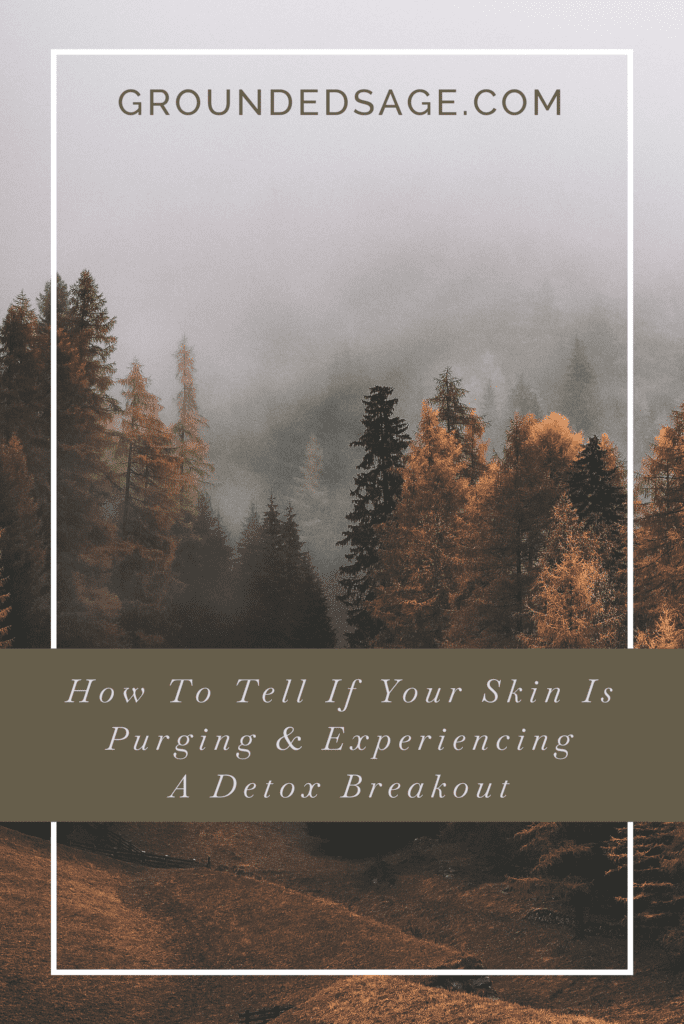
SaveSave
SaveSave


